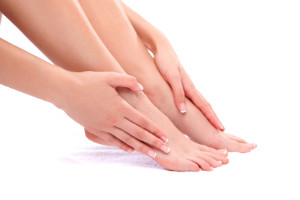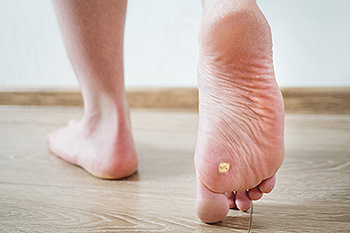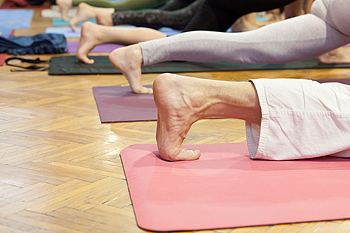
 There are many people who experience itchy feet at night. They typically do not have foot issues during the day but may find their feet to be itchy when trying to go to sleep. There are several reasons why this may happen. The condition known as Athlete’s foot may contribute to itchiness at night. Additionally, dry skin may play a significant role and may be remedied by using a good moisturizer. Research has indicated that nerve damage caused by diabetes or liver disease may result in itchy feet at night. It may help to manage ongoing stressful conditions, which may even provide mild relief. If you endure itchy feet at night, or know someone who does, please schedule an appointment with a podiatrist who can determine the cause and provide various treatment options.
There are many people who experience itchy feet at night. They typically do not have foot issues during the day but may find their feet to be itchy when trying to go to sleep. There are several reasons why this may happen. The condition known as Athlete’s foot may contribute to itchiness at night. Additionally, dry skin may play a significant role and may be remedied by using a good moisturizer. Research has indicated that nerve damage caused by diabetes or liver disease may result in itchy feet at night. It may help to manage ongoing stressful conditions, which may even provide mild relief. If you endure itchy feet at night, or know someone who does, please schedule an appointment with a podiatrist who can determine the cause and provide various treatment options.
Foot Pain
Foot pain can be extremely painful and debilitating. If you have a foot pain, consult with Dr. Edward D. Hutson from Easton, PA. . Our doctor will assess your condition and provide you with quality foot and ankle treatment.
Causes
Foot pain is a very broad condition that could be caused by one or more ailments. The most common include:
Diagnosis
To figure out the cause of foot pain, podiatrists utilize several different methods. This can range from simple visual inspections and sensation tests to X-rays and MRI scans. Prior medical history, family medical history, and any recent physical traumatic events will all be taken into consideration for a proper diagnosis.
Treatment
Treatment depends upon the cause of the foot pain. Whether it is resting, staying off the foot, or having surgery; podiatrists have a number of treatment options available for foot pain.
If you have any questions, please feel free to contact our offices located in Easton, and Northampton, PA . We offer the newest diagnostic and treatment technologies for all your foot care needs.
When your child is between 9 and 14 years old, the growth plate of the cartilage in the heel may not match the growth of the heel bone itself. This imbalance may cause a condition known as Sever’s disease, common in youngsters who play sports or are otherwise physically active. Luckily, it’s not actually a disease and will eventually subside as the child matures. Symptoms include swelling, stiffness in the feet, limping or walking on tiptoe, and pain in the heel. The main thing to do is stop the activity that may be at the root of the condition, especially if it calls for continued running and jumping on hard surfaces. Usually, low impact activities like swimming are not a problem. Sever’s disease generally subsides when the heel plate finishes growing, around the age of 15. If your younger teenage children are involved in sports, it is a good idea to introduce them to a podiatrist who can do regular examinations and treat any foot care problems as they arise.
Sever's disease often occurs in children and teens. If your child is experiencing foot or ankle pain, see Dr. Edward D. Hutson from Easton, PA. . Our doctor can treat your child’s foot and ankle needs.
Sever’s Disease
Sever’s disease is also known as calcaneal apophysitis, which is a medical condition that causes heel pain I none or both feet. The disease is known to affect children between the ages of 8 and 14.
Sever’s disease occurs when part of the child’s heel known as the growth plate (calcaneal epiphysis) is attached to the Achilles tendon. This area can suffer injury when the muscles and tendons of the growing foot do not keep pace with bone growth. Therefore, the constant pain which one experiences at the back of the heel will make the child unable to put any weight on the heel. The child is then forced to walk on their toes.
Symptoms
Acute pain – Pain associated with Sever’s disease is usually felt in the heel when the child engages in physical activity such as walking, jumping and or running.
Highly active – Children who are very active are among the most susceptible in experiencing Sever’s disease, because of the stress and tension placed on their feet.
If you have any questions, please feel free to contact our offices located in Easton, and Northampton, PA . We offer the newest diagnostic and treatment technologies for all your foot and ankle injuries.
 If you have a small growth or lesion near the base of your toes or bottom of the heel, you may have developed a plantar wart. Plantar warts are caused by HPV (human papillomavirus) which enters the foot through cuts or breaks in the skin on the bottom of the feet. These warts can grow beneath a callus on the foot if enough pressure is put on them. They can also cause pain or tenderness when standing or walking. Plantar warts are not particularly serious and may even go away on their own, but they can also remain, come back, or multiply. If you have a plantar wart, it is suggested that a qualified podiatrist examine your foot to verify the growth as well as provide treatments that increase your comfort.
If you have a small growth or lesion near the base of your toes or bottom of the heel, you may have developed a plantar wart. Plantar warts are caused by HPV (human papillomavirus) which enters the foot through cuts or breaks in the skin on the bottom of the feet. These warts can grow beneath a callus on the foot if enough pressure is put on them. They can also cause pain or tenderness when standing or walking. Plantar warts are not particularly serious and may even go away on their own, but they can also remain, come back, or multiply. If you have a plantar wart, it is suggested that a qualified podiatrist examine your foot to verify the growth as well as provide treatments that increase your comfort.
Plantar warts can be very uncomfortable. If you need your feet checked, contact Dr. Edward D. Hutson from Easton, PA. . Our doctor will assist you with all of your foot and ankle needs.
About Plantar Warts
Plantar warts are the result of HPV, or human papillomavirus, getting into open wounds on the feet. They are mostly found on the heels or balls of the feet.
While plantar warts are generally harmless, those experiencing excessive pain or those suffering from diabetes or a compromised immune system require immediate medical care. Plantar warts are easily diagnosed, usually through scraping off a bit of rough skin or by getting a biopsy.
Symptoms
Treatment
To help prevent developing plantar warts, avoid walking barefoot over abrasive surfaces that can cause cuts or wounds for HPV to get into. Avoiding direct contact with other warts, as well as not picking or rubbing existing warts, can help prevent the further spread of plantar warts. However, if you think you have developed plantar warts, speak to your podiatrist. He or she can diagnose the warts on your feet and recommend the appropriate treatment options.
If you have any questions please feel free to contact our offices located in Easton, and Northampton, PA . We offer the newest diagnostic and treatment technologies for all your foot and ankle needs.
Read more about All About Plantar Warts An effective stretch that benefits the bottom of the foot is known as a toe squat. It is known to strengthen the plantar fascia, which is the portion of tissue that is found on the sole of the foot. It connects the heel to the toes and is instrumental in performing daily activities that include walking and running. This stretch is performed by keeping your feet together as you are sitting on your heels. As the toes are tucked under, it is important to remain on the balls of the feet and avoid the tips of the toes. Breathing with the posture may intensify the stretch, as it is being held for two to three minutes. People who practice this stretch find it is beneficial to slowly release the position, and this can help to protect the bottom of the foot. If you would like to learn more about how to practice effective foot stretches, please speak with a podiatrist.
An effective stretch that benefits the bottom of the foot is known as a toe squat. It is known to strengthen the plantar fascia, which is the portion of tissue that is found on the sole of the foot. It connects the heel to the toes and is instrumental in performing daily activities that include walking and running. This stretch is performed by keeping your feet together as you are sitting on your heels. As the toes are tucked under, it is important to remain on the balls of the feet and avoid the tips of the toes. Breathing with the posture may intensify the stretch, as it is being held for two to three minutes. People who practice this stretch find it is beneficial to slowly release the position, and this can help to protect the bottom of the foot. If you would like to learn more about how to practice effective foot stretches, please speak with a podiatrist.
Why Stretching Is Important for Your Feet
Stretching the feet is a great way to prevent injuries. If you have any concerns with your feet consult with Dr. Edward D. Hutson from Easton, PA. . Our doctor will assess your condition and provide you with quality foot and ankle treatment.
Stretching the Feet
Stretching the muscles in the foot is an important part in any physical activity. Feet that are tight can lead to less flexibility and make you more prone to injury. One of the most common forms of foot pain, plantar fasciitis, can be stretched out to help ease the pain. Stretching can not only ease pain from plantar fasciitis but also prevent it as well. However, it is important to see a podiatrist first to determine if stretching is right for you. Podiatrists can also recommend other ways to stretch your feet. Once you know whether stretching is right for you, here are some excellent stretches you can do.
It is best to go easy when first stretching your foot and work your way up. If your foot starts hurting, stop exercising to ice and rest the foot. It is advised that you then see a podiatrist for help.
If you have any questions, please feel free to contact our offices located in Easton, and Northampton, PA . We offer the newest diagnostic and treatment technologies for all your foot care needs.
A band of tissue that connects your heel to your toes, called the plantar fascia, often becomes inflamed and is one of the most common causes of heel pain. Sometimes this tissue can also rupture, which may feel like a tearing pain in the arch of the foot. It is usually the result of a sports-related injury, especially while jumping and landing, or making sudden stops and starts. Although a plantar fascia rupture is relatively uncommon, it is far more prevalent in people with chronic plantar fasciitis and flat feet, as well as those involved in football, basketball, dancing, tennis and soccer. Swelling, tenderness, and bruising are common symptoms of this type of injury. Weight-bearing on the affected foot is extremely painful and not recommended. A podiatrist can examine your foot to determine the severity of the injury, usually with an imaging test. Pain medication, icing the area, and wearing a protective boot to stabilize the foot are among the ways to treat such a rupture. It’s a good idea to make an appointment with your podiatrist as soon as possible for an appropriate diagnosis and treatment plan.
Foot and ankle trauma is common among athletes and the elderly. If you have concerns that you may have experienced trauma to the foot and ankle, consult with Dr. Edward D. Hutson from Easton, PA. . Our doctor will assess your condition and provide you with quality foot and ankle treatment.
Foot and ankle trauma cover a range of injuries all over the foot; common injuries include:
Symptoms
Symptoms of foot and ankle injuries vary depending on the injury, but more common ones include:
Diagnosis
To properly diagnose the exact type of injury, podiatrists will conduct a number of different tests. Some of these include sensation and visual tests, X-rays, and MRIs. Medical and family histories will also be taken into account.
Treatment
Once the injury has been diagnosed, the podiatrist can than offer the best treatment options for you. In less severe cases, rest and keeping pressure off the foot may be all that’s necessary. Orthotics, such as a specially made shoes, or immobilization devices, like splints or casts, may be deemed necessary. Finally, if the injury is severe enough, surgery may be necessary.
If you have any questions, please feel free to contact our offices located in Easton, and Northampton, PA . We offer the newest diagnostic and treatment technologies for all your foot care needs.